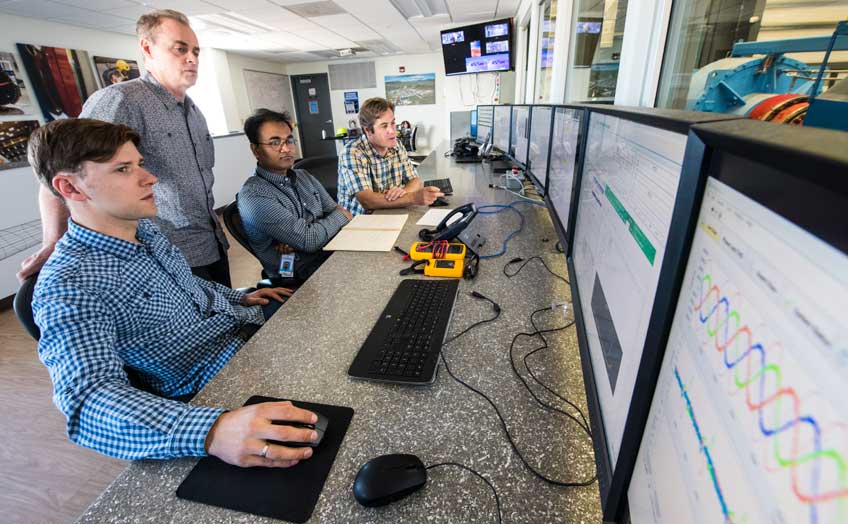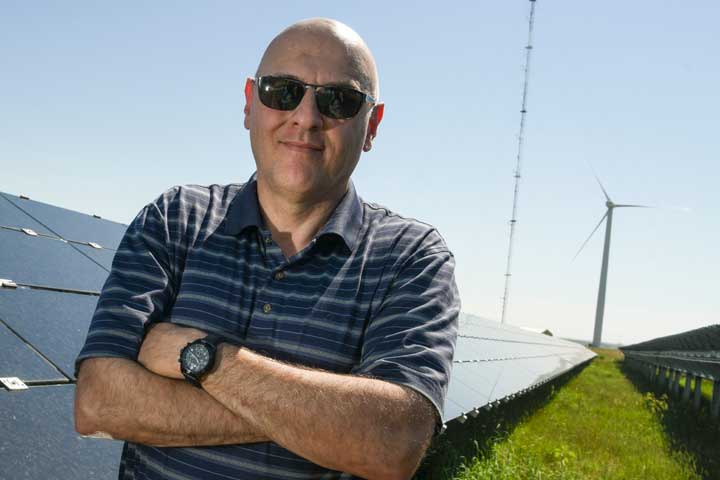Crosscutting Grid Research Facilities Provide Industry Launch Pad for Utility-Scale Evaluation
New grid integration technologies at the National Wind Technology Center (NWTC) have introduced a vast range in grid research capabilities—from multi-megawatt-scale wind and solar technologies to advanced energy storage devices, transformers, and protection equipment.

At 305 acres, the NWTC at the National Renewable Energy Laboratory (NREL) houses advanced grid research facilities with the capacity to generate more than 1.5 megawatts (MW) of solar energy and the space to add additional photovoltaic (PV) arrays. Combine that with 7 MW of installed, large-scale wind turbines and battery systems that provide millisecond response times, and the NWTC’s capabilities eclipse what NREL previously was able to offer researchers and collaborators. For the first time at a single site, researchers are generating renewable power from the sun and wind to study their effects on the actual grid, instead of relying on computer simulations.
“To make the biggest impact in industry, we need to be able to conduct experiments at the scale relevant to utilities,” said Ben Kroposki, director of NREL’s Power Systems Engineering Center. “The NWTC is unique in the United States as a place where you actually have full-scale wind turbines with PV and batteries all in one location.”
Kroposki and NREL Grid Integration Researcher Dave Corbus remember the days when most of the lab’s grid integration research occurred at the NWTC campus, just south of Boulder, Colorado. That changed in the fall of 2013, when the Energy Systems Integration Facility (ESIF) opened its doors at NREL’s campus in Golden, and the work migrated to the new building. While the ESIF is NREL’s flagship facility for systems integration research—including large-scale grid research—the work is more focused on simulation at the 1–2-MW level.
Combined, the NWTC’s turbines and a newly installed PV array can produce enough electricity to power 136,722 U.S. homes for a month. A controllable grid interface (CGI) allows researchers to both validate new equipment and gauge how well renewables interact with the grid.
“The controllable grid interface is really the heart and soul of what we can do in advanced grid integration testing,” Kroposki said. “The CGI provides the ability to test whole integrated energy systems—wind, PV, battery—and simulate grids that would be the size of small islands.”
That could prove useful for the Hawaiian island of Lanai, for instance, where the average demand for electricity daily reaches about 3 MW. “We could design a power system that would power that entire island,” Kroposki said. “As people start to think about how you get to 100% renewable energy systems, we could install a system that would replicate a lot of different types of power grids, at the scale that it would be installed, so that you could work out all the bugs and validate that those systems will work reliably and provide you with 24/7 power.”
The existing ethernet connection between the two NREL campuses allows researchers to run simulations based on the amount of renewable energy generated at the NWTC.
“This is the only place in the world where there’s a multi-megawatt grid simulation coupled with real multi-megawatt variable generation,” said Vahan Gevorgian, NREL chief engineer. “There are other places in the world that have grid simulators—Clemson University has a 15-MW grid simulator and there are a couple of other labs in Europe—but none of them are coupled or interfaced with the capabilities we have at NREL.”
Role of storage batteries explored

Gevorgian is principal investigator on a project now underway with First Solar, the Arizona company behind the newly installed PV array at NWTC. A key part of the company’s research involves combining PV with storage, said Mahesh Morjaria, vice president of PV systems for First Solar.
“Storage is a key enabler to ensure that the electricity generated from solar can be time-shifted to meet the needs of other durations,” said Morjaria. “Imagine clean electricity generated from solar during the daytime that can be used in the evening or nighttime. In that sense, work on storage and PV systems is essential to enable higher penetration of solar.”
Morjaria added: “Studies like this allow us to determine the size of the storage—and the performance of the storage—that is necessary to optimize that system because storage in general is expensive and the less we use, the better off we are.”
First Solar’s PV array at the NWTC can produce as much as 420 kilowatts, and each of the storage batteries can hold 1 MW. The ability to store generated energy proves helps when there is variability in the generation of renewable power, such as when clouds block the sun, or the wind dies down.
Other companies are interested in what researchers will find as they explore having a large wind farm and solar array on the same site. A key area to investigate, Corbus said, “is the perfect mix or a perfect resource location for wind and solar and grid interconnection. We’re seeing a lot of interest from industry in large-scale wind/PV hybrids. We haven’t seen that previously.”
Last Updated May 28, 2025
